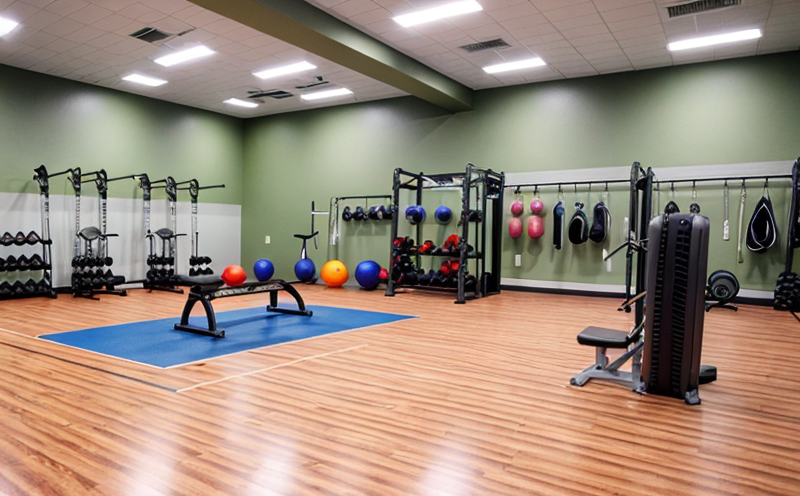Elasticity Testing of Resistance Bands
The elasticity testing of resistance bands is a critical aspect in ensuring product safety and performance. Resistance bands are widely used for fitness purposes, providing strength training by stretching under tension. Understanding the elasticity properties helps manufacturers to design products that meet specific stretch requirements while ensuring they do not fail under expected use conditions.
For consumers, knowing the elasticity of resistance bands is essential as it directly impacts their effectiveness and safety during workouts. Manufacturers must adhere to rigorous standards to ensure consistent performance across all units produced. This testing involves measuring how much a band stretches before breaking point and how quickly it returns to its original length after stretching.
Testing typically follows international standards such as ASTM F2839 for fitness resistance bands, which specifies the procedures and requirements for mechanical tests of elastic exercise resistance bands. These standards provide guidance on selecting appropriate specimens, controlling testing environments, and interpreting results accurately.
The process begins with careful selection of representative samples from each batch or production run. Specimens are then prepared according to standard guidelines; this includes cutting them into uniform lengths and ensuring they are free from defects that could affect test outcomes.
Testing equipment used is calibrated to provide precise measurements within narrow tolerance ranges, ensuring accurate data collection throughout the process. During testing, samples are subjected to incremental load application until failure occurs due to stretching beyond elastic limit or breaking point.
After each measurement, the sample returns to its original shape, indicating its elasticity property. Data from multiple tests are analyzed statistically to determine average values and variability within batches.
Results of these tests play a vital role in quality control processes, helping manufacturers identify potential issues early on so corrective actions can be taken promptly. They also assist in identifying optimal material choices for future products by comparing different materials' elasticity characteristics.
Accurate elasticity testing ensures that resistance bands meet specified performance criteria set forth by regulatory bodies and industry associations. Compliance with these standards not only protects consumers but also enhances brand reputation, fostering customer trust and loyalty.
Why Choose This Test
Selecting the right elasticity test for resistance bands can significantly impact product quality and consumer satisfaction. Here are several reasons why choosing this type of testing is beneficial:
Enhanced Consumer Safety: By ensuring that resistance bands do not stretch too much or break suddenly, manufacturers protect users from potential injuries during workouts.
Better Performance: Products designed with accurate elasticity characteristics perform better, offering consistent resistance levels throughout the exercise cycle.
Regulatory Compliance: Adhering to relevant standards like ASTM F2839 ensures compliance with legal requirements and industry expectations, reducing risks of recalls or penalties.
Brand Reputation: Consistently high-quality products build trust among consumers, leading to increased market share and customer loyalty.
Innovation Opportunities: Understanding elasticity properties can lead to innovations in material selection and design improvements that enhance product functionality.
Economic Benefits: Reducing defects through thorough testing reduces waste during production and minimizes warranty claims, saving costs for both manufacturers and retailers.
International Acceptance and Recognition
The elasticity testing of resistance bands enjoys widespread international recognition due to its critical role in ensuring product safety and performance. International standards such as ASTM F2839 have been adopted by numerous countries around the world, reflecting their importance in global markets.
These standards provide a common framework for manufacturers across different regions to follow, ensuring consistency in testing methods and results. This harmonization facilitates trade between nations while maintaining high-quality expectations for consumers globally.
Incorporating internationally accepted practices into local testing protocols helps companies meet global market demands without compromising on quality or safety standards. It also simplifies compliance processes when expanding into new markets, reducing barriers to entry and promoting fair competition among businesses operating internationally.
Competitive Advantage and Market Impact
Incorporating rigorous elasticity testing into your product development process can provide significant competitive advantages in the sporting goods and fitness equipment market. Here’s how:
Better Reputation: Consistent quality and reliability build a strong brand reputation, which is crucial for attracting loyal customers.
Increased Market Share: Superior products often attract more buyers, increasing your share of the overall market.
Premium Pricing Power: High-quality products can command premium prices, enhancing profitability margins.
Innovation Leadership: Being at the forefront of adopting advanced testing methodologies sets you apart from competitors and positions you as a leader in innovation.
Customer Satisfaction: Satisfied customers are more likely to recommend your products positively, driving word-of-mouth marketing efforts.
Sustained Competitive Edge: Continuous improvement based on robust testing ensures long-term competitiveness even amidst changing market trends and consumer preferences.





